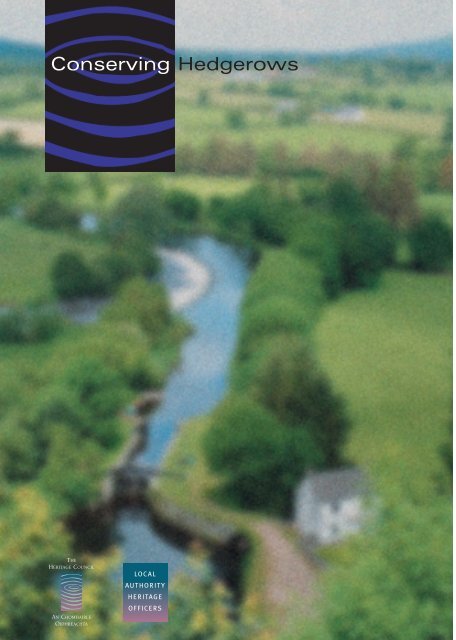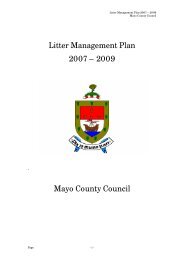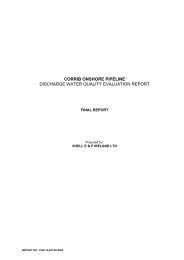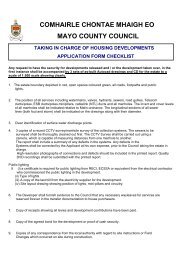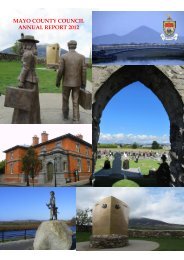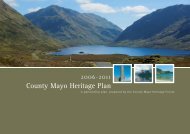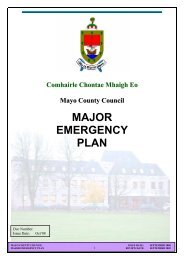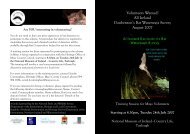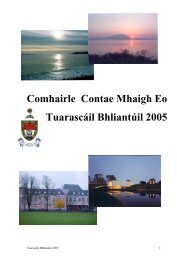Conserving Hedgerows - The Heritage Council
Conserving Hedgerows - The Heritage Council
Conserving Hedgerows - The Heritage Council
- No tags were found...
You also want an ePaper? Increase the reach of your titles
YUMPU automatically turns print PDFs into web optimized ePapers that Google loves.
<strong>Conserving</strong> <strong>Hedgerows</strong>THEHERITAGE COUNCILAN CHOMHAIRLEOIDHREACHTALOCALAUTHORITYHERITAGEOFFICERS
MAINTENANCE<strong>Hedgerows</strong> must be managed to encourage their long-termconservation and development. Proper maintenance encouragesflowering, fruiting, vigour, and wildlife potential. <strong>The</strong> age, condition,composition, and function of the hedgerow will dictate whatmaintenance is required. Mature hedgerows in good conditionshould be allowed to grow naturally, with maintenance confined toessential practices such as stockproofing, inplanting, and the controlof invasive species. Weak hedgerows, which have lost their vigour, willrequire more intervention such as laying or coppicing. A hedgerowshould have a dense base, form an unbroken barrier, and be at least1.5 m high. An established hedge will need cutting every two to threeyears. <strong>The</strong>re is considerable wildlife benefit if maintenance is done inrotation around the farm to ensure that there is growth at all stages.If possible, one side of the hedge should be trimmed at a time.(i) Landowners should check every hedge to assess its generalcondition. Identify desirable species; the most valuable forwildlife include oak, birch, mountain ash, hawthorn, alder, willow, ash, holly, crab, and Scots pine.Where mechanical cutting is required, those saplings identified for retention should have the vegetationaround them cleared manually and be clearly marked to alert the machine operator.(ii) Hedges should be cut while they are dormant, from thebeginning of September to the end of February (Section 46Wildlife Act 2000).(iii) Hedges should be cut to an A-shaped profile, with a bushy topfor maximum protection from wind. This will encourage thedevelopment of a dense hedge. Square cut hedges will put outa twiggy, lateral growth, encroaching on roads and paths sothat summer cutting is requested for reasons of safety andconvenience.(iv) Overgrown or neglected hedges with sufficient vigour may berestored by coppicing – selective cutting at ground level topromote bushy regrowth.(v) Hedge-laying involves the part cutting through of selected stems, bending them over at an angle of 70-80degrees, and securing the stems. This can be part of the long-term maintenance cycle of a hedgerow andis recommended as a method of hedge-rejuvenation and stockproofing.(vi) Gaps in hedgerows that cannot beclosed by laying should be plantedwith hawthorn quicks, blackthornor other suitable native species atnot more than 30 cm (1ft) spacingin prepared ground. <strong>The</strong> youngplants should be cut back to halftheir height after planting topromote growth.(vii) Do not apply herbicides, pesticides or fertilisers within 1.5 m of a hedgerow, as this leads to nutrientenrichment that can adversely affect biodiversity.(viii) <strong>The</strong> preferable method of hedge maintenance is by hand tools. Where this is not practical, particularcare should be give to the correct use of machinery. Remember the importance of sharp tools andregular maintenance of equipment.(ix) <strong>The</strong> crushing of hedgerows by heavy machinery must not be permitted.(x) Finger bar cutters with a pair of reciprocating blades are very suitable for trimming young growth.(xi) A flail cutter should only be used on soft growth of thorny species, and never on heavy woody growth:the resulting ragged ends are unsightly and invite disease. Smooth wood species such as willow, hazeland cherry are not well suited to flail cutting.(xii) A circular saw should only be considered for coppicing and must not be used for general hedgerowmaintenance.(xiii) Fencing wire must not be attached to hedgerow trees and shrubs.(xiv) Where practicable, hedge trimmings should be piled in a non-intrusive manner to provide habitat. Ifhedge trimmings are to be removed or burned, this must be done immediately after cutting.
THE ROLE OF LOCAL AUTHORITIESIn the formulation of development plans local authorities arecommitted to designating landscapes and their associatedcharacteristics, under the Planning & Development Act, 2000.Through the planning process local authorities can also ensure thathedgerows are given due regard with respect to hedgerowconservation.In recent years many local authorities have been creativelymanaging roadside verges to ensure a diversity of plants cansurvive. This ideal can be broadened to include hedgerowsabutting roads. Each local authority has a responsibility to roadusers and their safety on public roads and while some maintenanceis required to hedgerows at some locations, every effort must bemade to ensure that best practice is exercised in this regard.For more information contact:Crann, Crank House, Main Street, Banagher, Co. Offaly. Tel: (0509) 51718, Fax: (0509) 51938,E-mail: info@crann.ie, Website: www.crann.ie.<strong>Heritage</strong> <strong>Council</strong>, Rothe House, Kilkenny. Tel: (056) 70777, E-mail heritagecouncil@heritage.iol.iefor contact details of your local authority heritage officer, Website www.heritagecouncil.ie.Networks for Nature, 107 Lower Baggot Street, Dublin 2. Tel: (01) 6768860,E-mail: networks4nature@eircom.net, Website: www.networksfornature.com.Teagasc Countryside Management, Kildalton, Piltown, Co.Kilkenny. Tel: (051) 643105,E-mail: ckeena@kildalton.teagasc.ie, Website: www.teagasc.ie.Illustrations by Maggie Raynor. Photographs by Neil Foulkes, Lorcan Scott and with permissionfrom the RSPB.


